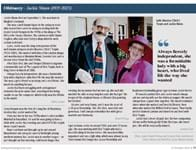Copyright is of fundamental importance in the art world.
By way of example, see ATG Nos 2577 and 2595 (January 28 and June 3, 2023) concerning the Andy Warhol Foundation and copyright claims against it, which went all the way to the US Supreme Court.
However, the law in the US and in the UK is different.
For many a year, the phrase used to describe the accepted low level of originality in the UK required for a work to obtain copyright has been that all the author needs to do is demonstrate something along the lines of “sufficient skill, judgment or labour” to justify copyright protection.
This has traditionally been a low bar which requires only relatively limited input to get past the tape. Even with a photograph, not too much is required to be done, under this test, to acquire copyright. As long as it clearly went further than being a straight copy then there was the possibility that copyright could emerge from the photograph.
This remains the widely understood test by many, including on a major public company law firm website.
New position
This is, however, no longer the up to date test, and there has been a recent Court of Appeal judgment in November 2023 confirming the updated position.
As this judgment sets out and as is well known: “In order for copyright to subsist in an artistic work it must be “original”: section 1(1)(a) of the [Copyright Designs and Patents] Act 1988”.
The judgment goes on to state: “Section 1(1)(a) of the 1988 Act must, so far as possible, be interpreted in accordance with Article 2(a) of European Parliament and Council Directive 2001/29/EC of 22 May 2001 on the harmonisation of certain aspects of copyright and related rights in the information society (“the Information Society Directive”) as interpreted prior to 31 December 2020 by the Court of Justice of the European Union”.
It then states: “In Case C-5/08 Infopaq International A/S v Danske Dagblades Forening [2009] ECR I-6569 the Court of Justice held at [37] that “copyright within the meaning of Article 2(a) of Directive 2001/29 is liable to apply only in relation to a subject-matter which is original in the sense that it is its author’s own intellectual creation” [my italics].
The judgment then drills further into what exactly this means, saying: “What is required is that the author was able to express their creative abilities in the production of the work by making free and creative choices so as to stamp the work created with their personal touch.”
Rather remarkably you may think (although the Court of Appeal was very generous to him), the judge in the court below the Court of Appeal, i.e. the High Court from which the appeal was made, used the old “sufficient skill and labour” test.
As the Court of Appeal said, “these two tests are not the same” i.e. the new European test is plainly more demanding.
However, rather luckily for the High Court Judge, the Court of Appeal, even in applying the more demanding test, emerged with the same decision in relation to whether copyright subsisted in the graphic work in issue in the case, namely that the Claimant did indeed have copyright in the work, despite the more stringent test of the Court of Justice of the European Union.
No doubt the High Court Judge heaved a sigh of relief on that one.
The bottom line is that this higher and more demanding test is likely to be of considerable importance in the future in the art world, even though a High Court Judge appears to have missed it entirely in May 2023.
It has already been argued that museums have wrongly been charging licence fees for copyright which doesn’t in fact exist.
Milton Silverman is senior commercial dispute resolution partner at Streathers Solicitors LLP, London.












